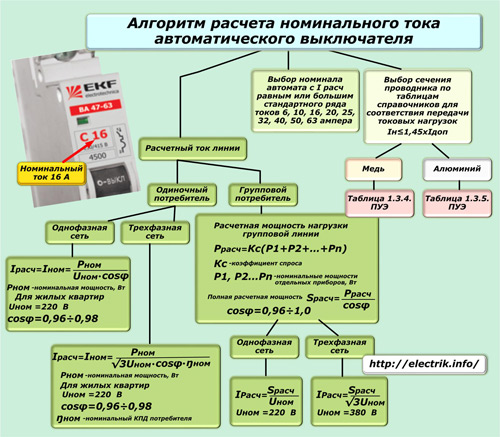Categories: Automata and RCD
Number of views: 62079
Comments on the article: 4
Selection of circuit breakers for an apartment, house, garage
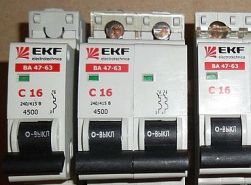 A home foreman, who started repairing or making electrical wiring for his premises, always faces the issue of protecting his electrical equipment from preventing the development of possible emergency situations in it.
A home foreman, who started repairing or making electrical wiring for his premises, always faces the issue of protecting his electrical equipment from preventing the development of possible emergency situations in it.
Circuit breakers that provide three functions allow this problem to be solved:
1. convenient manual switching of connected circuits with power sources;
2. reliable transmission of load current in operating mode;
3. protective automatic shutdown in case of emergencies.
It is no secret that any such device is created by the manufacturer to provide certain technical capabilities and has various characteristics. Therefore, there are a lot of such designs and for each particular workplace it is necessary to select the optimal machine.
Well, now let's move on to the selection rules, dividing them into nine consecutive stages.
Calculation of the rated current. Stage number 1
A circuit breaker is usually installed inside the switchboard at the entrance to a house, apartment or garage and cut into a phase conductor. The current of the connected load, which is created by working electrical appliances, passes through this machine through the mounted wires.
It is this current in the operating mode that the circuit breaker must reliably pass, and if it is exceeded, it must open its power contact, de-energizing the circuit. It is important that a balance is maintained between the conductive properties of the electrical wiring and the connected devices.
For example, copper wiring with a cross-section of 1.5 mm square can provide reliable power supply to consumers with a total capacity of up to 1 kW. If you connect an electric heater that takes 3 kW from the network to it, then no circuit breaker in this situation can cope with the protection function and normal power supply.
After all, choosing an automatic machine for a load of 1 kW, we will protect the wiring, we will not allow it to overheat and fail due to increased currents. However, the electric heater will not work - the protection will immediately automatically turn off the power every time it is turned on.
If you choose a circuit breaker for a 3 kW heater load, then its equipment will begin to work, but only until the power wires burn the voltage supply. And it will happen pretty quickly.
The given example demonstrates that the issue of the balance of the electrical circuit connected to the machine must be analyzed and provided at the design stage of the work before choosing a specific model of protective devices.
In this case, it is best to gradually complete the following three tasks:
1. calculate the current of the connected line based on the power of the electrical appliances operating in it, taking into account their number and the number of phases of the network;
2. Select the rating of the circuit breaker from a number of standard currents based on the calculation. In this case, the rounding up method is used;
3. determine the material and the cross-section of wires that will transfer the load from the machine to consumers based on the use of PUE tables.
The picture below shows the main technical recommendations for solving each of these issues.
Selection of a circuit breaker according to its time-current characteristic. Stage number 2
The dependence of the speed of removal of power from the load by the electromagnetic release on the excess of the rated current in the controlled circuit is one of the important indicators of the machine. According to this criterion, they have six classification groups, but only three of them are suitable for the conditions of a house, apartment and garage.
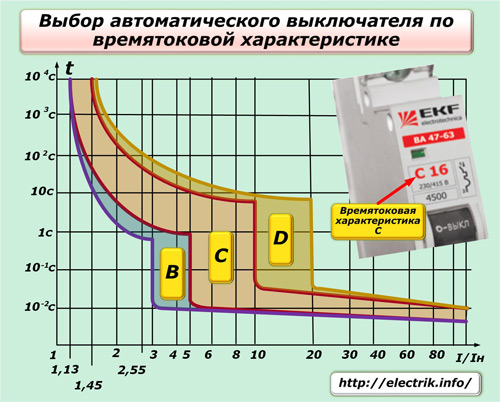
These are the classes:
-
“B”, when the load is represented by old electrical wiring, incandescent lamps, heaters, electric stoves or ovens;
-
“C”, if the premises use washing and dishwashers, refrigerators, freezers, air conditioners, office and home outlet groups, gas discharge lamps with an increased start current;
-
“D” - to ensure reliable operation and protection of powerful compressor units, pumps, processing machines, lifting mechanisms.
Reliable disconnection of the increased current by an electromagnetic release occurs when the class I exceeds the nominal:
-
In at 3 ÷ 5;
-
C - 5 ÷ 10;
-
D - 10 ÷ 20 times.
Currents greater than 10% of the nominal value will also be switched off by these machines due to the operation of bimetallic plates operating on the thermal principle. But, their time can not always provide security. Therefore, class D protections cannot be used in place of C or even more so B.
Selection of circuit breaker according to the principle of selectivity. Stage number 3
Choosing a protective device, it should be understood that it does not work alone in the electrical circuit, but in combination with other machines. For them, they create their own, specific sequence of responses, called selectivity or selectivity. It is important to comply with it to ensure reliable supply of electricity to all consumers.
The principle of the selective operation of the circuit breakers is demonstrated by the picture, which shows that when a short circuit occurs in the device connected to the outlet, the emergency current will pass through the automatic devices AB1 of the switchboard at home, AB2 of the driveway and AV3 of the apartment panel.

At the same time, they need to be selected so that the malfunction is quickly eliminated by the work of the AV3 machine closest to the shutdown location, and the rest continue to work to power all the connected consumers.
During the design of the configuration of electrical protection circuits, they are always backed up, assuming that there can be no absolute reliability. Someday, the AB3 circuit breaker may fail for various reasons. Therefore, it should be insured by the nearest AB2 to it. In the event of its breakdown, the AB1 operation will turn on. Etc…
In addition, we present the design of a selective automaton, which is installed in the main distribution panel. Such special selective switches can provide a delay time of about 0.25 ÷ 0.6 seconds.

They have prepared 2 ways for passing current:
-
main;
-
additional.
They have the same elements for the operation of thermal releases and the main contact block.
Such a selective automaton is installed in front of the outgoing one, and its main channel works for the usual shutdown of an accident. An additional resistor is included, providing a small decrease in current and, accordingly, a delay in response to time.
If the outgoing machine eliminates the accident, the selective one does not turn off, but remains in operation through an additional contact, and after cooling of the main bimetal and through its channel. When the outgoing machine does not cope with its task, then its work is reserved by the second additional chain.
Determination of the ultimate switching ability of contacts. Stage number 4
This characteristic determines the value of the maximum current in amperes that the circuit breaker can reliably break in the event of an emergency. If this value is exceeded in practice, then the network protection may not be fulfilled, and the machine itself will simply burn out due to the increased arc power.
One of the decisive parameters for choosing a machine according to PKS is connected with the material of the used wires in the supply cables and the distance of the object from the transformer substation.

In addition to the ultimate ability, the technical documentation also indicates the switching wear resistance, which determines the number of operation cycles under normal conditions until the moment of wear of the mechanism.
Current limitation class of the disconnecting mechanism. Stage number 5
This parameter is indicated on the case of most of the highest quality models and characterizes the shutdown speed of the emergency mode with electromagnetic cutoff in relation to the length of a segment of one half-cycle of a standard sinusoid.
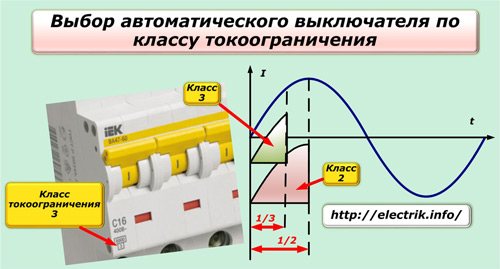
The current limitation class is indicated by the numbers 1, 2, 3, which are the denominators of the fraction with numerator 1.
A machine with class 2 should begin to respond to a malfunction in 1/2 half time, and in the third class, 1/3. This means that the higher the current limit indicator, the faster the accident is eliminated and the protected equipment is less exposed to heat.
When the electric current of the accident breaks, an arc occurs, which is extinguished by a special device. The final fault interruption time by the 3rd class automatic machine is about 2.5 ÷ 6 milliseconds, the 2nd - 6 ÷ 10, and the 1st -> 10.
Please note that class 3 models do not allow the emergency current to reach its maximum peak. Therefore, their choice is most optimal.
Checking the circuit breaker for phase-zero loop resistance. Stage 6
This question is best entrusted to the specialists of measuring electrotechnical laboratories. The technology and methodology for its implementation are described separate article.
Now let's briefly recall that the term phase-zero loop refers to the entire section of the electrical circuit from the winding of the power supply transformer located at the substation to the final consumer outlet.

This circuit has electrical resistance and affects the choice of protective devices because this value is limited by the maximum current of the resulting short circuit.
For example, the measured line impedance is 1.2 Ohms. The voltage in the apartment wiring is 220 volts. If you short-circuit the socket contacts with a metal jumper, then, according to Ohm's law, you can determine the current that has arisen.
Ikz = 220 / 1.2 = 183.3 (3) A.
At the design stage of wiring, this value is determined theoretically from the calculation tables.
For example, protections are selected for a garage where it is planned to use metalworking machines. Therefore, for all previously estimated indicators, an automatic machine for 16 amperes of class D was selected.
The breaking capacity of its electromagnetic release is calculated according to the requirements of the PUE according to the formula:
I = 1,1x16x20 = 352 A.
-
16 - rated current of the machine;
-
20 - maximum characteristic of the multiplicity of the tripping current by an electromagnetic release;
-
1,1 - margin of 10%.
The calculation showed that the maximum short-circuit current in the circuit can be no more than 183 amperes, and the selected circuit breaker operates at a short circuit of 352 A. In other words, the current cutoff for most accidents in this model simply will not work.
Therefore, the machine is not selected correctly. It must be replaced. There is another alternative - the modernization of the wiring in order to reduce its electrical resistance.
Number of poles. Stage 7
In a single-phase circuit, a two-pole circuit breaker is installed inside the input shield to ensure complete removal of phase and zero voltage from the fed circuit. In other cases, unipolar models that break the phase potential are used.
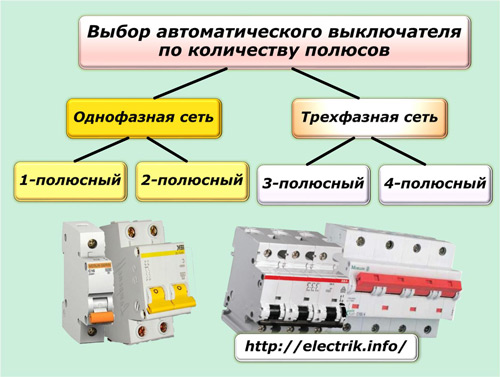
A four-pole circuit breaker in a three-phase network allows three phases and a working zero to be switched at once. But, in no case should they break the protective PE conductor.
In other cases, when the working neutral conductor does not need to be switched, it is enough to choose a three-phase model.
Extra options. Stage 8
This includes features such as:
-
voltage value of the input network;
-
frequency of industrial oscillations in hertz (usually 50 or 60);
-
degree of protection of the housing according to IP classes;
-
execution for operation at the deteriorated temperature.
It is also necessary to pay attention to them, especially if severe working conditions are planned for the machine.
Brand selection. Stage 9
This final point is usually important when not one protective device is purchased, but a whole series of them for electrical work in one house. It is recommended to purchase reliable models of well-known manufacturers, taking into account purchasing opportunities.
In any case, choosing many varieties is not recommended. Throughout the building, it is best to use machines of one trusted company and series.
Consider the more severe operating conditions of circuit breakers in cold or poorly heated garages and other similar rooms.
In conclusion, I would like to draw attention to one very important stage of working with a circuit breaker, which is often forgotten. This is loading or, in other words, an electrical check of all the specifications declared by the manufacturer from an external source in real operating conditions of the test with fixing the results and drawing up a protocol.
Perform its electrical laboratories on their equipment. Such an independent check allows you to identify all the malfunctions that could appear in the machine after its transportation or long-term storage, including factory defects.
See also at bgv.electricianexp.com
:

